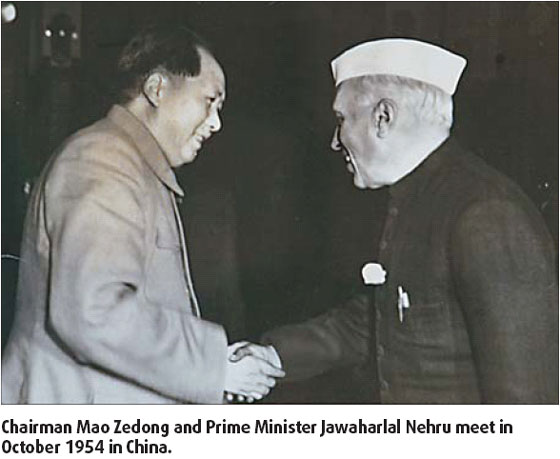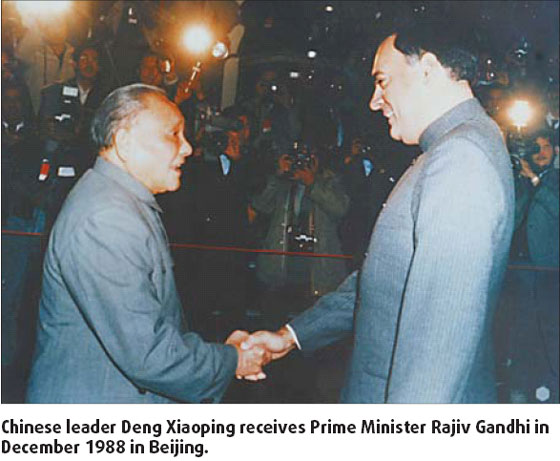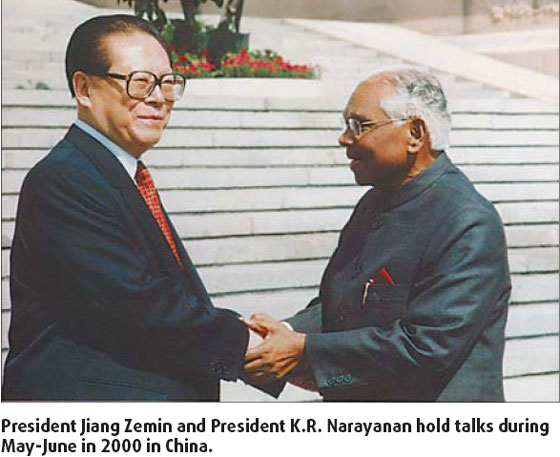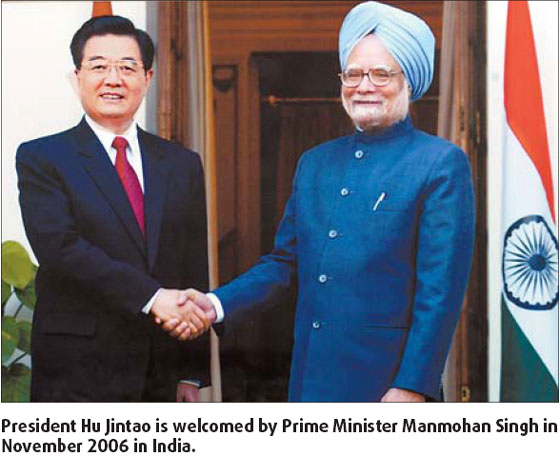High points of Sino-Indian diplomatic relations

Chinese Premier Zhou Enlai visited India in June 1954. Indian Prime Minister Jawaharlal Nehru visited China in October 1954.
The visit of Indian Prime Minister Rajiv Gandhi in December 1988 was the first visit to China by an Indian head of government in over three decades and set the stage for the deepening of bilateral ties in all spheres, while seeking to resolve outstanding issues through peaceful and friendly consultations.
Premier Li Peng paid a return visit to India in December 1991, followed by the visit of Indian Prime Minister P. V. Narasimha Rao to China in September 1993.
Indian President R. Venkataraman visited China in May 1992. This was followed by the visit of President Jiang Zemin in November 1996. Both trips were first visits by respective heads of State to either country.
Indian President K. R. Narayanan visited China during May-June in 2000 which coincided with the 50th anniversary of the establishment of diplomatic ties between India and China.
Premier Zhu Rongji visited India in February 2002.
Indian Prime Minister Atal Bihari Vajpayee visited China in June 2003. The two sides issued a Declaration for Relations and Comprehensive Cooperation.
Premier Wen Jiabao visited India in April 2005, during which it was decided to establish Strategic and Cooperative Partnership for Peace and Prosperity between the two countries.

During President Hu Jintao's visit to India in November 2006, a ten-pronged action-oriented strategy was announced in order to substantiate Strategic and Cooperative Partnership of the two countries in all areas.
Mrs. Sonia Gandhi, Chair person of the ruling United Progressive Alliance (UPA) of India, visited China in October 2007.
Political relations
There have been many high-level ministerial visits from both sides, and functional cooperation frequent and institutionalized, which has included various areas like water resources, counter-terrorism, youth exchange, defense, internal security and social sectors.
Intense exchange among political parties and parlia-mentarians.
Cooperation and coordination on regional and international issues, including in trilateral dialogue involving Russia.
Progress on boundary question
India-China Joint Working Group (JWG) on the Boundary Question was set up in 1988.

The two sides signed an Agreement on the Maintenance of Peace and Tranquility along the Line of Actual Control in the India-China Border Areas in 1993. India-China Expert Group of Diplomatic and Military Officials (EG) was set up under the JWG.
An agreement on Confidence Building Measures in the Military Field along the Line of Actual Control (LAC) in the India-China Border Areas was signed in 1996. Additional measures were added in 2005.
In 2003, the two sides decided to appoint Special Representatives to explore the framework of a boundary settlement from the political perspective of the overall bilateral relationship.
Agreement on the Political Parameters and Guiding Principles for the Settlement of the India-China Boundary Question was signed as an outcome of the first stage of the Special Representatives' talks in 2005.
So far, special representatives of the two sides have met for 11 rounds of talks.
People-to-people cooperation
A Bilateral Cultural Exchange Program was signed in 1988. 2006 was declared Year of India-China Friendship, while the year 2007 was celebrated as the Year of India-China Friendship through Tourism. A Cultural Exchange Program for 2007-09 has also been signed between the two nations.
Direct flights commenced in 2002. There are 22 direct flights per week between India and China.
Exchange of students by the two governments was institutionalized in 1988. At present, there are nearly 7,000 Indian students across China.
Science and technology
An inter-governmental agreement was signed in December 1988 with the formation of Joint Committee on Science and Technology Cooperation.
Furthering the exchange of scientists and researchers on both sides seen as the first step toward enabling the understanding of each other's situation. Interactions through join working groups formed under different MoUs have led to useful exchanges, thus providing grounds for future cooperation. The scope of future cooperation remains vast as both countries are engaged in developing capabilities in emerging fields of science and technology.
Mechanism of coordination in S&T cooperation has been elevated to a higher level with the formation of a Joint Steering Committee, co-chaired by Ministers of Science and Technology on both sides, in September 2006. This apex body will guide and facilitate cooperative activities under various protocols / agreements.

In the Joint Declaration of November 2006, the two sides agreed to establish India-China partnership in S&T cooperation for coordinating and bolstering bilateral S&T relations. They also agreed to work toward joint projects in earthquake engineering, climate change, and weather forecasting as well as nano-technology with the focus on advanced materials and bio-technology.
Defense cooperation
High-level exchanges started with the visit of the Indian Defense Minister to China in 1992 and have remained rather frequent since then.
First-ever joint search-and-rescue drills between the two Navies in 2003; first-ever joint training exercise between the two Armies in 2007.
Courtesy of the Indian Embassy in China
(China Daily 01/14/2008 page14)














